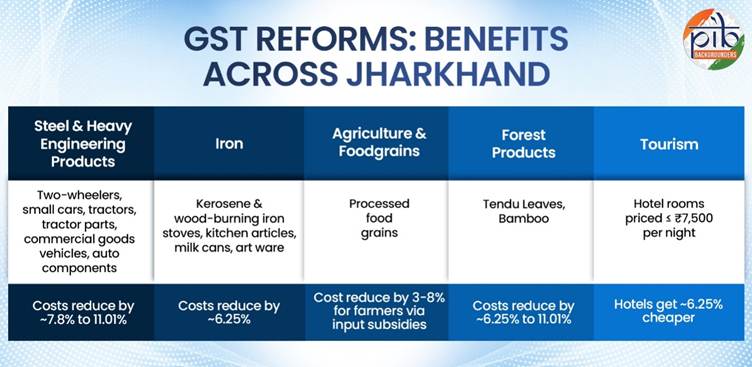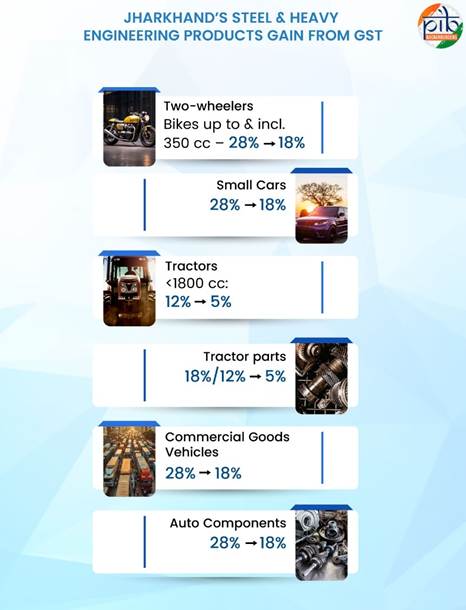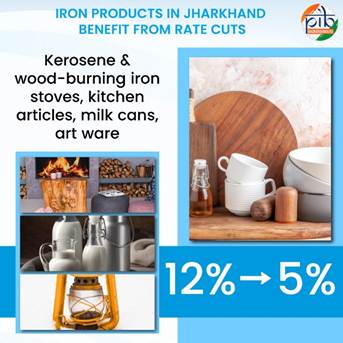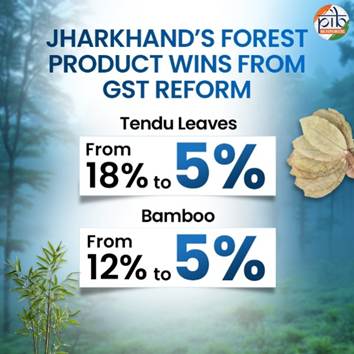PIB Headquarters
GST Reforms Unlock Economic Potential in Jharkhand
Posted On:
11 OCT 2025 11:38AM by PIB Delhi
Introduction
Formed in 2000, Jharkhand is a state in eastern India distinguished by its abundant natural resources, robust steel and heavy engineering industries, and vast iron ore reserves. Forests and woodlands occupy over 29% of the state which is amongst the highest in India. A tribal-dominated state, Jharkhand's economy also draws significant strength from agriculture and allied sectors, which support a large portion of its population.
The recent GST reforms bring substantial rate reductions across major industries and have a transformative impact on Jharkhand’s economic landscape. By lowering costs and improving affordability, these reforms not only stimulate domestic consumption but also enhance the global competitiveness of Jharkhand’s industrial and mineral exports. Additionally, the reforms catalyse employment opportunities along the value chains of agriculture, manufacturing, and services.

Steel & Heavy Engineering Products
Steel and heavy engineering form the backbone of Jharkhand’s industrial development, contributing nearly 20–25% of India’s total steel output. The state hosts major industrial hubs such as Jamshedpur (Tata Steel) and Bokaro (SAIL-Bokaro Steel Plant), alongside an extensive network of metallurgy-based supply chains spread across Singhbhum and Bokaro districts. This ecosystem sustains a large formal workforce- over 1 lakh people (1,04,309 as of 2022–23 as per the Ministry of Statistics and Programme Implementation), and supports a dense vendor and MSME base engaged in fabrication and services.
The primary consumers of Jharkhand’s steel and heavy engineering products include the domestic construction, infrastructure, automotive, and capital goods industries. The state also exports value-added steel products to key international markets such as the USA, China, Japan, Nepal, Bangladesh, and Europe, reinforcing its position as a crucial player in both domestic and global value chains.
The recent GST reforms further strengthen the state's industrial momentum. Sectors that consume Jharkhand’s steel stand to benefit from reduced GST rates. The tax on two-wheelers (bikes up to and including 350cc) and small cars has been cut from 28% to 18%, while tractors below 1800cc now attract 5% instead of 12%. Similarly, tractor parts have seen reductions from 18%/12% to 5%, and commercial goods vehicles from 28% to 18%. GST rates for auto components have been brought down from 28% to 18%.
Notably, these rate cuts lower costs across the auto and machinery value chain by 7.8%–11.0%, making vehicles and equipment affordable and boosting demand. The resulting uptick in production, logistics, and fabrication spurs higher capacity utilization in Jharkhand’s steel and heavy engineering sector, generating wider employment, increasing MSME orders, and deepening linkages across the state’s manufacturing ecosystem.

Iron

Jharkhand is endowed with abundant mineral wealth, accounting for nearly 26% of India’s total iron ore reserves. The state’s iron industries produce a diverse range of goods, including kerosene and wood-burning stoves, kitchenware, milk cans, and art ware, primarily concentrated in the West Singhbhum (Noamundi and Gua), Singhbhum belt, and Kolhan region. The sector operates through a mix of large-scale mining enterprises- both public and private- and small community-led units, where many tribal and forest-fringe communities participate while also relying on seasonal agriculture for supplementary income.
Around one lakh people are employed in Jharkhand’s iron industry, which supplies to domestic steel mills, including those in neighboring Odisha, as well as to local steel plants for captive consumption. Additionally, exports of select ores and minerals are directed to key global markets such as China, Japan, Europe, and Southeast Asia, reinforcing Jharkhand’s role in the international supply chain.
Under the recent GST reforms, the tax rate on iron has been reduced from 12% to 5%, leading to an estimated cost reduction of about 6.25% across various product categories. This move enhances price competitiveness, improves profit margins for producers and exporters, and stimulates growth and employment within Jharkhand’s iron-based industries.
Agriculture & Foodgrains
Agriculture in Jharkhand is primarily driven by marginal and small farmers, many of whom belong to tribal communities and depend on a mix of subsistence farming and non-timber forest produce (NTFP)-based livelihoods. According to a report by NCAER and NITI Aayog, the sector contributed18.2% to Jharkhand's Gross State Domestic Product (GSDP) in 2021–22. About 50.4% of the state's working population is engaged in agriculture and allied activities.
The plateau and valley districts- notably Ranchi, Hazaribagh, Palamu, and Latehar, form the agricultural heartland. The key buyers of agricultural produce include domestic mandis, processing industries, state procurement agencies, and NTFP aggregators. While Jharkhand’s overall exports are dominated by minerals and industrial goods, agricultural exports continue to be limited in scale.
The recent GST reforms have introduced a rate reduction on processed foodgrains from 12% to 5%, which is a direct benefit to farmers. This measure reduces input costs by 3–8%, thereby improving farm profitability, encouraging value addition and processing, and enhancing rural income stability across the state.
Forest Products

Jharkhand’s identity is deeply intertwined with its forests since ancient times- the very name ‘Jharkhand’ translates to “land of forests.” Both in spirit and reality, the state embodies a rich legacy of forest and biodiversity conservation, which remains an integral part of its cultural and ecological ethos.
The districts of Hazaribagh, Latehar, and West Singhbhum hold extensive forest cover, supporting a large tribal population that depends heavily on NTFP for sustenance and seasonal income. Key products include lac, tendu leaves, and honey, with lac being particularly significant as a regionally important livelihood source.
The forest-based industry in Jharkhand sustains nearly 20 lakh poor and tribal workers, whose livelihoods are closely linked to associated activities. Major domestic buyers include the Jharkhand State Forest Development Corporation (JSFDC), local agro-processors, and the construction industry. On the export front, Jharkhand’s forest produce reaches markets in Bangladesh, the USA, the EU, Southeast Asian countries, and the Middle East.
The recent GST reforms further strengthen this sector’s economic viability. The GST rate on tendu leaves has been reduced from 18% to 5%, and on bamboo from 12% to 5%, leading to an estimated cost reduction of 6.25% to 11.01%. These reductions increase price competitiveness, raise producer margins, and enhance income security for forest-dependent communities across Jharkhand.
Tourism

Jharkhand, with its hills, dense forests, and waterfalls, offers visitors a chance to experience nature in its raw and relatively untouched form. Beyond its natural beauty, the state also features museums, temples, and wildlife sanctuaries that reflect its cultural and ecological diversity. Since its formation from Bihar over two decades ago, Jharkhand has been steadily shaping its identity as a developing but promising tourist destination, balancing its industrial character with efforts to promote eco- and cultural tourism. Key destinations include Deoghar (Baidyanath Dham), Parasnath (Jain pilgrimage), Rajrappa (Rajrappa Temple), Jagannath temple (Ranchi area).
Jharkhand’s tourism economy is supported by a wide network of small hotel and homestay owners, lodge and guesthouse staff, local guides, naturalists, transport operators (taxi and tempo drivers), food service workers, handicraft artisans, local traders, and community hosts in tribal villages who offer experiential tourism.
Under the recent GST reforms, Jharkhand’s tourism and hospitality sector stands to gain. The tax rate on hotel rooms priced at ₹7,500 or below per night has been reduced from 12% to 5%, making stays roughly 6.25% cheaper. These rate cuts bring down the cost of food and beverage services, making travel and accommodation more affordable for visitors while offering some relief to the state’s small and mid-scale tourism operators.
Conclusion
Endowed with rich minerals, forests, and natural wealth, GST reforms are a boost for Jharkhand, with rates lowered across steel, iron, agriculture, forest products, and tourism sectors. These rate reductions strengthen the state's industrial and mineral base, enhance farm and forest incomes, and make tourism and hospitality more affordable. Collectively, the GST reforms accelerate industrial growth, revitalize rural enterprises, and create inclusive employment opportunities, positioning Jharkhand as a more competitive and investment-ready economy.
References
jharkhand.gov.in
https://www.jharkhand.gov.in/
knowindia.india.gov.in
https://knowindia.india.gov.in/states-uts/jharkhand.php
incredibleindia.gov.in
https://www.incredibleindia.gov.in/en/jharkhand
Click here to see pdf
****
VV/M
(Release ID: 2177714)
Visitor Counter : 1436